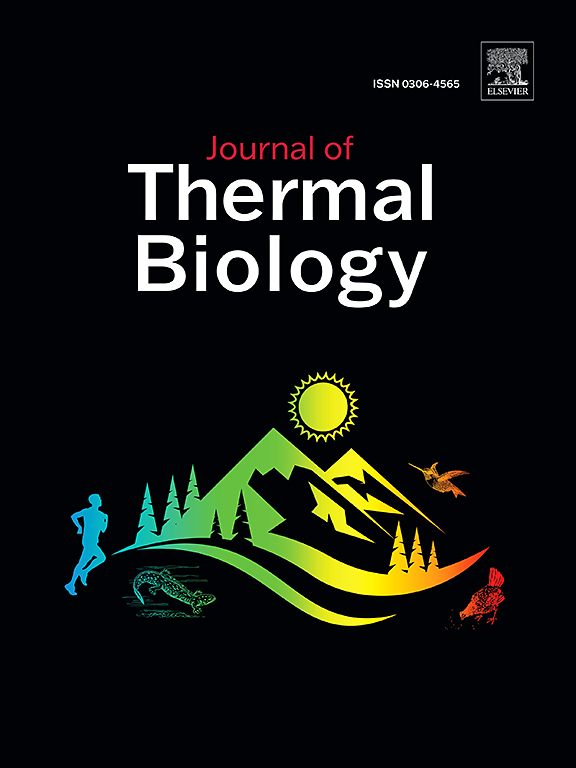Seasonal and depth-dependent thermoregulatory benefits of burrows for wombats – The largest burrowing marsupials
IF 2.9
2区 生物学
Q2 BIOLOGY
引用次数: 0
Abstract
Mammals use burrows to behaviourally thermoregulate, save water, and avoid predation. The advantages of burrows vary not only seasonally but also with burrow depth. To quantify these effects, we used biophysical ecological models, which predict an animal's energetic and hydric costs within a characterised microclimate. For Australia's three extant wombat species, we quantified variation in the energetic advantage of burrows spatially, temporally, and with burrow depth. We simulated resting wombats with different traits (e.g., body size, fur) in different microclimates (above ground and burrows of varying depth) at six sites across Australia, two for each wombat species, over five years (1980, 1990, 2000, 2010, 2020). We assessed time spent within their thermoneutral zone—heat production equals heat loss thus minimising energy and water expenditure —and frequency of extreme heat stress (i.e., no viable hydric solution for the conditions stipulated). Our findings show that burrows are essential for reducing energetic and hydric costs and for survival during the hottest season in areas with no shade, e.g., the semi-arid zone. We found no evidence that extreme heat stress has increased temporally i.e., due to climate change, but it was frequently predicted in shallow burrows in 2020, having rarely been previously forecast. For energy requirements, we found lower thermoregulatory costs for deeper burrows in the cold season and for shallow burrows in the hot season. This work underscores the critical balance between wombat survival, burrow utility, and environmental dynamics, offering new insights into mechanisms that dictate mammal behaviour from a thermoregulatory perspective.
袋熊洞穴随季节和深度而变化的体温调节功能 - 最大的穴居有袋类动物
哺乳动物利用洞穴进行行为体温调节、节约用水和避免捕食。洞穴的优势不仅随季节变化,而且随洞穴深度变化。为了量化这些影响,我们使用了生物物理生态模型,该模型可以预测动物在特定小气候条件下的能量和水分成本。对于澳大利亚现存的三种袋熊,我们对洞穴的能量优势在空间、时间和洞穴深度上的变化进行了量化。我们在澳大利亚的六个地点模拟了不同特征(如体型、皮毛)的袋熊在不同微气候(地面和不同深度的洞穴)下的休息情况,每个袋熊物种有两个地点,历时五年(1980、1990、2000、2010、2020)。我们评估了袋熊在热中性区(产热量等于散热量,从而最大限度地减少能量和水分消耗)内所花费的时间,以及极端热应激(即在规定条件下没有可行的水力解决方案)的频率。我们的研究结果表明,洞穴对于降低能量和水力成本以及在最炎热季节在无遮荫地区(如半干旱地区)生存至关重要。我们没有发现极端热应激在时间上增加的证据,即由于气候变化,但2020年在浅洞穴中经常出现极端热应激,而以前很少预测到。在能量需求方面,我们发现寒冷季节较深洞穴的体温调节成本较低,而炎热季节较浅洞穴的体温调节成本较高。这项研究强调了袋熊生存、洞穴效用和环境动态之间的关键平衡,从体温调节的角度为哺乳动物行为的决定机制提供了新的见解。
本文章由计算机程序翻译,如有差异,请以英文原文为准。
求助全文
约1分钟内获得全文
求助全文
来源期刊

Journal of thermal biology
生物-动物学
CiteScore
5.30
自引率
7.40%
发文量
196
审稿时长
14.5 weeks
期刊介绍:
The Journal of Thermal Biology publishes articles that advance our knowledge on the ways and mechanisms through which temperature affects man and animals. This includes studies of their responses to these effects and on the ecological consequences. Directly relevant to this theme are:
• The mechanisms of thermal limitation, heat and cold injury, and the resistance of organisms to extremes of temperature
• The mechanisms involved in acclimation, acclimatization and evolutionary adaptation to temperature
• Mechanisms underlying the patterns of hibernation, torpor, dormancy, aestivation and diapause
• Effects of temperature on reproduction and development, growth, ageing and life-span
• Studies on modelling heat transfer between organisms and their environment
• The contributions of temperature to effects of climate change on animal species and man
• Studies of conservation biology and physiology related to temperature
• Behavioural and physiological regulation of body temperature including its pathophysiology and fever
• Medical applications of hypo- and hyperthermia
Article types:
• Original articles
• Review articles
 求助内容:
求助内容: 应助结果提醒方式:
应助结果提醒方式:


